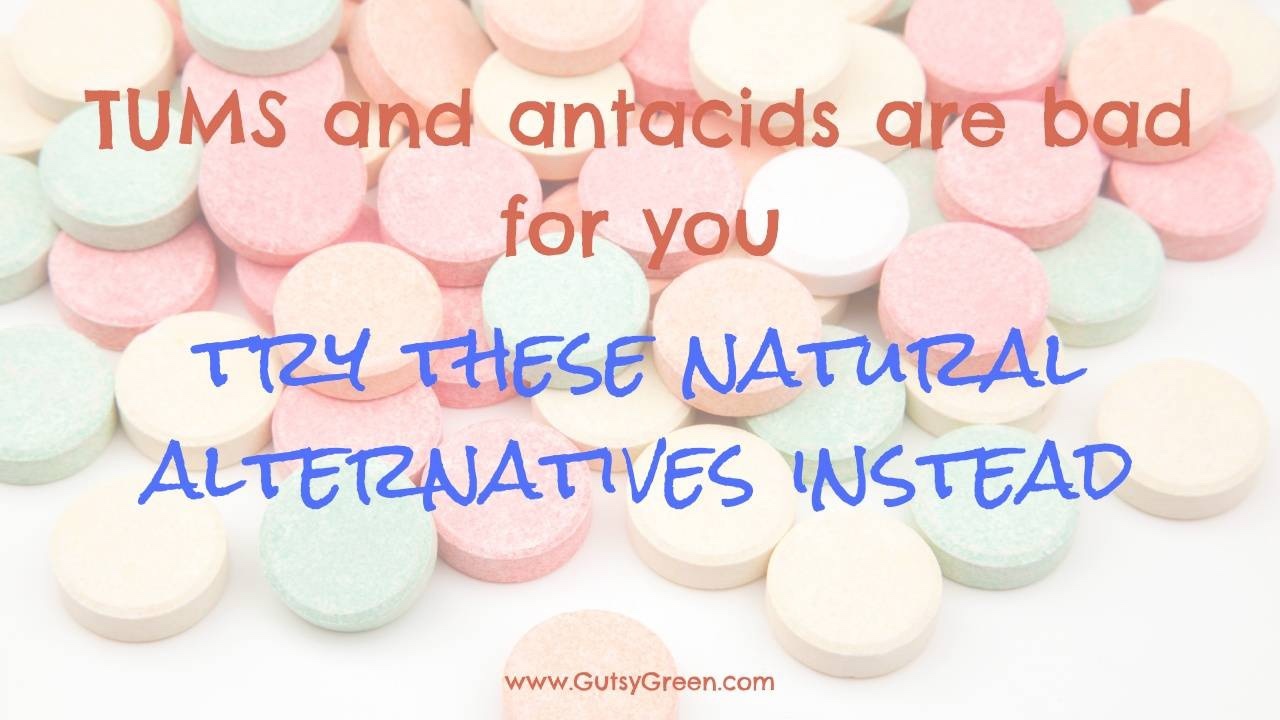TUMS and antacids are bad for you - here's what to do instead

Let’s be honest: reaching for the TUMS or antacids after a meal has sort of become like an American pastime.
And hey, even though this well-accepted approach is most definitely a band-aid for what’s really going on, at least it’s not fundamentally compromising digestive function in a long-term way like acid-blocking medications and proton-pump inhibitors do (I’m looking at you, Prilosec).
TUMS and their other antacid buddies work *temporarily* and can thus be considered to be far more preferable to pharmaceuticals that work by turning your gastric acid faucet completely off.
Turns out, we need those acid secretions to carry out 3 pivotal roles in the body:
-
Acting as an acid barrier by killing ingested microbes
-
Breaking food down into safe and digestible forms
-
Signaling the other digestive processes to begin or end
…the foundational nature of these services makes turning your stomach acid off a bad idea – to say the least.
But, even though TUMS and antacids are preferable to more invasive pharmaceuticals as a means to treat reflux and indigestion symptoms, they’re still not great.
Afterall:
-
Their ingredients are problematic.
-
They’re actively disrupting proper stomach function.
-
They are still not working to address the ROOT CAUSE of the problem.
Not to mention, there’s a much more natural alternative that can be used to manage symptoms that avoids all of these problems.
Let’s examine each of these issues with TUMS and antacids more thoroughly before we get into what this alternative is.
Problem #1: They have horrible ingredients.
Here’s a peak at the TUMS label, so we can actually understand what’s in these puppies:

Yeesh! If we start by checking out those inactive ingredients, we can see that these fun-colored-candy-looking tablets are actually filled to the brim with artificial colorings (hello, cancer), sugars, and other additives. The sizable concentration of synthetic compounds in here masquerading as food products are dangerous enough to serve as a deterrent for consuming these bad boys at all regularly.
As you may have noticed, the active ingredient is called Calcium Carbonate. While calcium carbonate isn’t inherently dangerous to consume in amounts found in nature, context is important here. This massive dose actually works to undermine the body’s digestive process, which may be dangerous if done regularly over time.
This leads us into our second problem…
PROBLEM #2: They disrupt proper stomach function.
Calcium carbonate, in the doses present in antacid products, works by binding with the hydrogen in our stomach’s hydrochloric acid (HCl), working to neutralize the acid into a more basic substance.
When thinking about acidity it’s useful to understand the metric by which we measure acidity, which is a scale called the ‘power of hydrogen’ or ‘pH’. This scale runs from 0 to 14, where 0 is the most acidic (think battery acid), 14 is the most basic (think drain cleaner), and 7 is completely neutral (think water).
Our stomach’s pH has been shown to be optimal between 1.5 and 3.0 – very acidic. In fact, if the stomach’s pH creeps up to just outside of this window, to say, 3.5 or 4.0, it can compromise the stomach’s ability to perform it’s 3 very important roles for the body.
And when we take TUMS or any other antacid, we are raising our stomach acid pH outside of this optimal window and into danger territory. While this may alleviate symptoms (which we’ll talk about more below), it is impairing our innate ability to safely digest our food.
This can result in the following consequences:
-
Our acid barrier goes down and pathogens can enter into our body and cause trouble.
-
Our food is improperly broken down, leading to malabsorption and nutrient deficiencies, as well as undigested food particles causing structural damage to the intestines.
-
Our signaling cascades are disrupted, leading to failure to secrete pancreatic enzymes, fat-digesting bile, and for the gateways to the stomach to open and shut properly.
PROBLEM #3: They don’t address the root cause of acid symptoms.
Ironically, as we discuss in this article, it is actually when the stomach acid is NOT acidic enough that we tend to experience symptoms like reflux, heartburn, or GERD.
This has to do with gastric acid’s role as a signaling entity that works to properly calibrate the function of the Lower Esophageal Sphincter (LES). When the stomach acid is too weak and has a pH outside of the 1.5 – 3.0 optimal window, this LES gateway between the stomach and esophagus can remain open at improper times, allowing the acidic contents in the stomach to reflux up into the esophagus and burn the sensitive tissue there.
TUMS and antacids work by neutralizing the contents of the stomach to a water-like substance. This way, the tissue won’t burn when it refluxes back up into the esophagus. However, this is NOT fixing the ROOT CAUSE of the problem. The LES is still remaining open. Meanwhile, taking this neutralization approach will also undermine your body’s ability to glean any nutrients from your food, and to protect your intestines from microbial invaders.
Now, if you use antacids not for reflux, but for an acidic feeling in the stomach, TUMS are STILL not your friend. Your problem is that your protective mucosa in the stomach is inflamed, not that you have too much acid.

When the acidic contents of the stomach come into contact with the tissue for too long – which happens all.the.time. for people with slow motility or delayed emptying time – the stomach’s mucosa begins to erode and become inflamed. When the stomach is in this condition, any amount of acid is going to irritate it!
As we’ve established, we need stomach acid. So where does that leave us?
Well, to attack the root cause of the dysfunction here, we’ve got to get your digestion moving normally again, and we’ve got to rebuild your mucosa. Counterintuitively, delayed motility and emptying time is often caused by too little stomach acid, which can lead to the stomach trying to hold on to its contents for an extended period of time in order to try to break down the food enough for the next step in digestion to safely occur.
THE ANSWER: Give your mucosa some TLC, and then work on reacidifying your stomach.
So instead of constantly chewing franken-tablets like TUMS to neutralize your stomach acid, which ultimately works to make your problems worse by compromising digestive function, attack the root cause.
First, heal your stomach’s mucosa and your esophageal lining by ingesting targeted nutrients to soothe and repair. Here are a list of the ingredients I work with in my practice to accomplish this task, shown in literature to nourish and improve healing time:
Finally, once you’ve successfully healed your mucosa, you should begin to think about restoring the proper pH, and by extension, function, of your stomach.
Want to learn more about our signature S.A.F.E. framework to normalize your stomach function? Check out this article.


